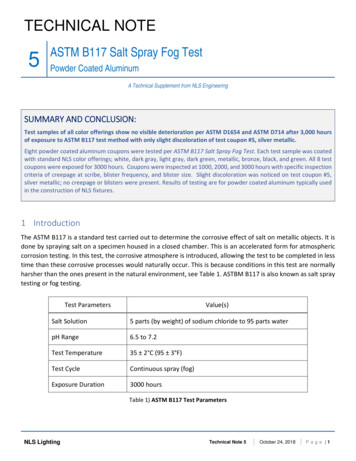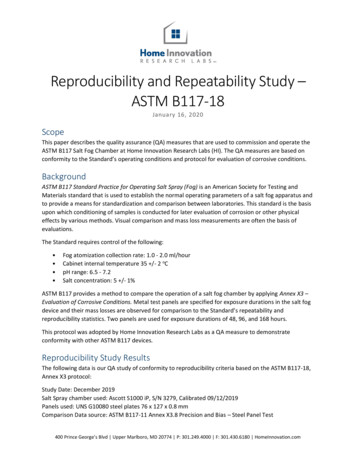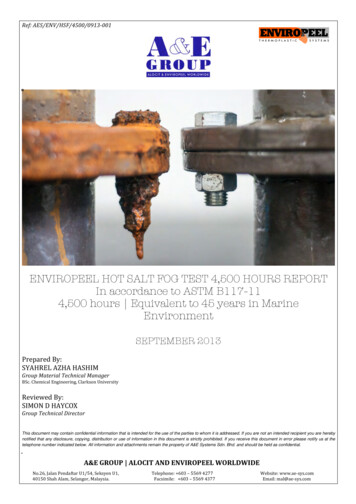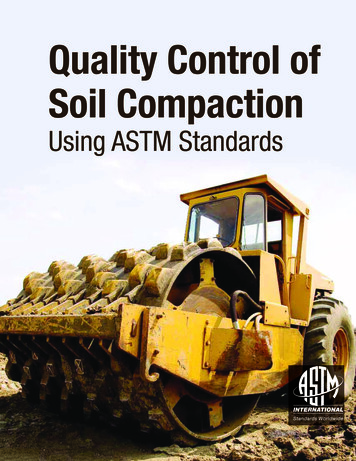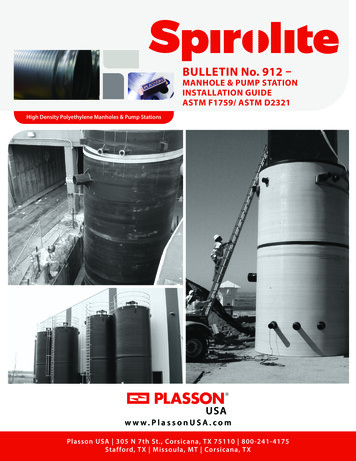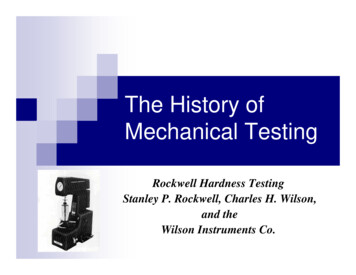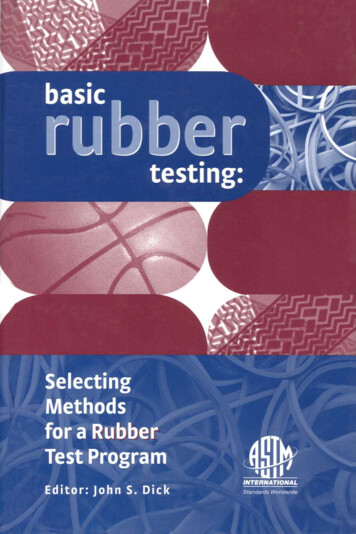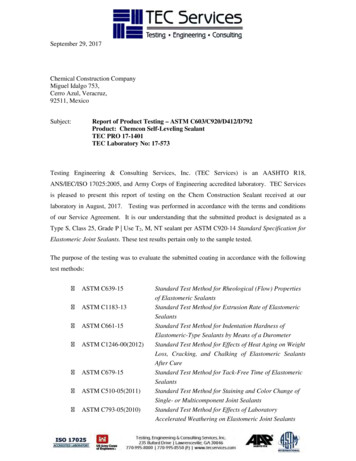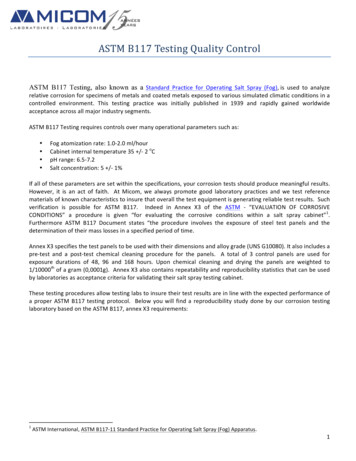
Transcription
ASTM B117 Testing Quality ControlASTM B117 Testing, also known as a Standard Practice for Operating Salt Spray (Fog), is used to analyzerelative corrosion for specimens of metals and coated metals exposed to various simulated climatic conditions in acontrolled environment. This testing practice was initially published in 1939 and rapidly gained worldwideacceptance across all major industry segments.ASTM B117 Testing requires controls over many operational parameters such as: Fog atomization rate: 1.0-2.0 ml/hourCabinet internal temperature 35 /- 2 oCpH range: 6.5-7.2Salt concentration: 5 /- 1%If all of these parameters are set within the specifications, your corrosion tests should produce meaningful results.However, it is an act of faith. At Micom, we always promote good laboratory practices and we test referencematerials of known characteristics to insure that overall the test equipment is generating reliable test results. Suchverification is possible for ASTM B117. Indeed in Annex X3 of the ASTM - “EVALUATION OF CORROSIVECONDITIONS” a procedure is given “for evaluating the corrosive conditions within a salt spray cabinet”1.Furthermore ASTM B117 Document states “the procedure involves the exposure of steel test panels and thedetermination of their mass losses in a specified period of time.Annex X3 specifies the test panels to be used with their dimensions and alloy grade (UNS G10080). It also includes apre-test and a post-test chemical cleaning procedure for the panels. A total of 3 control panels are used forexposure durations of 48, 96 and 168 hours. Upon chemical cleaning and drying the panels are weighted to1/10000th of a gram (0,0001g). Annex X3 also contains repeatability and reproducibility statistics that can be usedby laboratories as acceptance criteria for validating their salt spray testing cabinet.These testing procedures allow testing labs to insure their test results are in line with the expected performance ofa proper ASTM B117 testing protocol. Below you will find a reproducibility study done by our corrosion testinglaboratory based on the ASTM B117, annex X3 requirements:1ASTM International, ASTM B117-11 Standard Practice for Operating Salt Spray (Fog) Apparatus.1
Reproducibility StudyASTM B117 Testing – Operating Salt Spray (Fog) ApparatusStudy Date:Salt Spray chamber used:Panels used:Data source:January 2014MI-EQ-477 – Model CTT 1100 – 13-1152-40UNS G10080 steel plates 76 x 127 x 0.8 mmASTM B117-11 X3.8 Precision and Bias - Steel Panel TestThe ASTM reproducibility study gives the acceptable limits (with a 95% reproducibility limit) on the consistency ofmass loss results from different labs and cabinets.Reference data:The statistical data used below are from the precision and bias ASTM study detailed in ASTM B117-11 « OperatingSalt Spray (Fog) Apparatus ».Table 1: ASTM2 reproducibility study0h48h96h168hAverage mass loss(g)--0.81701.53472.5996Standard Deviation SR(g)--0.09470.20190.3255Coefficient of variation limits Cv (%)--11.58%14.02%12.52%R (g)--0.26520.56530.9114Table 2: Micom resultsDate13 Jan 201415 Jan 201417 Jan 201420 Jan 2014Exposure (h)0h48h96h168hMassPlate #1 (g)77.561076.834876.038474.3876Mass lossPlate #1 (g)--0.72621.52263.1734MassPlate #2 (g)76.694275.976475.122273.3142Mass lossPlate #2 (g)--0.71781.57203.3800Table 3: Comparison – Mass loss (Micom vs. ASTM study)Acceptable values (95% rep. limit)Average ṁ (g)Micom results0h--48h0.722096h1.5473168h3.2767Note 1: R 2.8 x SR2Average ṁ (g)ASTM study--0.81701.53472.5996Minṁ - R (g)--0.55180.96941.6882Maxṁ R (g)--1.08222.10003.5110Acceptation level: Resultsmust be within (ṁ R)--Within rangeWithin rangeWithin rangeThe largest ASTM study (data from 12 cabinets) was used as reference.2
Table 4: Comparison – Coefficient of variation (Micom vs. ASTM study)Average ṁ (g)Micom’s results0h--48h0.722096h1.5473168h3.2767Note 2: CV (%) 100 x (SR / ṁ)Average ṁ (g)ASTM study--0.00590.03490.1461Coefficient of variation CVMicom’s results (%)--0.82%2.26%4.46%Coefficient of variation limit CVASTM study (%)--11.58%14.02%12.52%Graphic representationConclusion:Micom results are within ASTM B117 acceptable corrosion rates.3
Repeatability StudyASTM B117 Testing– Operating Salt Spray (Fog) ApparatusStudy Date:Salt Spray chamber used:Panels used:Data source:January 2014MI-EQ-477 – Model CTT 1100 – 13-1152-40UNS G10080 steel plates 76 x 127 x 0.8 mmASTM B117-11 X3.8 Precision and Bias - Steel Panel TestThe ASTM repeatability study gives the acceptable limits (with a 95% reproducibility limit) on the consistency ofmass loss results from panels tested simultaneously in a cabinet.Reference data:The statistical data used below are from the precision and bias ASTM study detailed in ASTM B117-11 « OperatingSalt Spray (Fog) Apparatus ».Table 1: ASTM3 repeatability studyAverage mass loss (g)0h48h96h168h--0.81701.53472.5996Standard Deviation Sr(g)--0.05880.10480.2498r (g)--0.16460.29340.6994Coefficient of variation limits Cv (%)--7.20%7.28%9.61%Table 2: Micom resultsDate13 Jan 201415 Jan 201417 Jan 201420 Jan 20143Exposure (h)0h48h96h168hMassPlate #1 (g)77.561076.834876.038474.3876Mass lossPlate #1 (g)--0.72621.52263.1734MassPlate #2 (g)76.694275.976475.122273.3142Mass lossPlate #2 (g)--0.71781.57203.3800The largest ASTM study (data from 12 cabinets) was used as reference.4
Table 3: Comparison – Mass loss (Micom vs. ASTM study)Acceptable values (95% rep. limit)Acceptance level: Resultsmust be within (ṁ r)Average ṁ (g)Average ṁ (g)MinMaxMicom resultsASTM studyṁ - r (g)ṁ r (g)0h----------48h0.72200.81700.65240.9816Within range96h1.54731.53471.24131.8281Within range168h3.27672.59961.90023.2990Within rangeNote 3: Each result from the ASTM study is the average of 2 steel panels tested simultaneously. Each result fromMicom’s study is also the average of 2 steel panels tested simultaneously in the same cabinet.Note 4: r 2.8 x Sr5
Table 4: Comparison – Coefficient of variation (Micom vs. ASTM study)Average ṁ (g)Micom0h--48h0.722096h1.5473168h3.2767Note 5: CV (%) 100 x (Sr / ṁ)Standard DeviationSr (g)Micom--0.00590.03490.1461Coefficient of variation CVMicom (%)--0.82%2.26%4.46%Coefficient of variation - limit CVASTM (%)--11.58%14.02%12.52%Graphic representationConclusion:Micom’s results meet ASTM B117 requirements for precision and bias of corrosion rates.6
Please note that this Quality Control process is currently not available for ASTM G85 test. However we aredeveloping a set of data that could be used for this test method.For more information about ASTM B117 testing or additional corrosion testing, we invite you to contact us. It willbe our pleasure to answer your questions.This article is a preview of the Corrosion Testing white paper that we are currently working on and that will beavailable in the following months. If you would like to be notified when our white paper on corrosion comes out,we invite you to send us an email.DisclaimerAll of the information and opinions contained in this blog are made with the information, and theunderstanding that we have reviewed at the time of publishing. However, despite our efforts, we do not offerany guarantee of their accuracy, thoroughness of our investigation or validity. The author of this blog is notliable for any inaccuracies or any losses or damages that may result from the use of the information or datacontained herein. This blog has not been reviewed or verified for its accuracy by any peer group associatesprior to publication.7
ASTM B117 Testing – Operating Salt . Please note that this Quality Control process is currently not available for ASTM G85 test. However we are developing a set of data that could be used for this test method. For more information about ASTM B117 testing or additional corrosion testing, we invite you to contact us. It will be our pleasure to answer your questions. This article is a preview .
